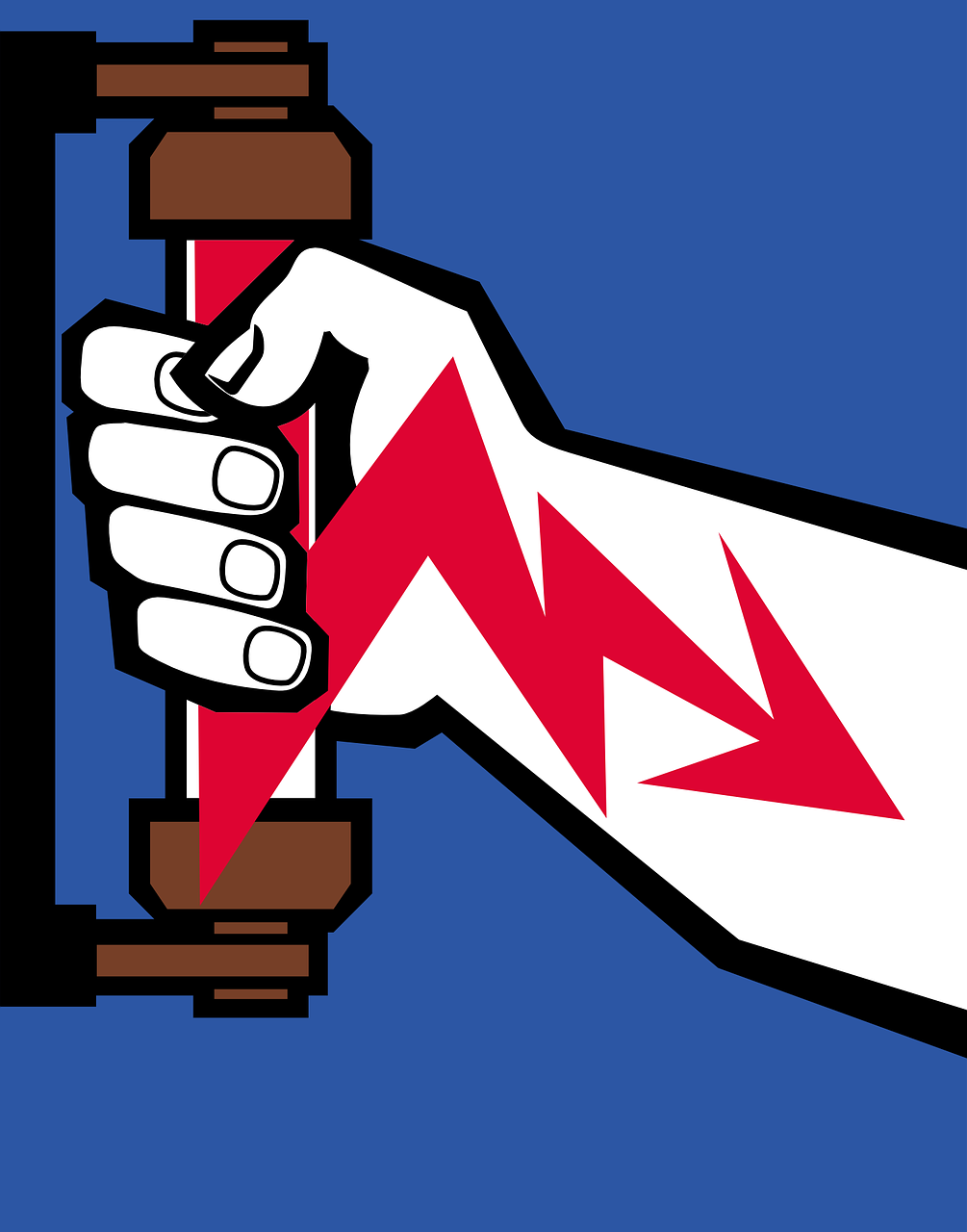The Human Body and the Electric Shock
Electricity is genuinely a good slave, but an evil master as some must have learned the hard way when they received an electric shock.
Often you may have overheard someone say, "It is not the voltage that kills you but the current."

[Pixabay]Source
Well, that may be as true as saying it's not the gun that kills you but the bullet!
Current cannot flow on itself without voltage. Even the Ohm's law states that voltage V=IR which makes voltage directly proportional to the current (I) which is a function of resistance (R).
Current is the flow of electrons or even electron-deficient atoms that are electrical charge carriers.
The standard unit is ampere represented by A.
One ampere is equal to one Coulomb of electrical charge; this coulomb represents 6.24 x 10 18 charge carries that moves across a specific point in one second.
In other words, it is simply the number of charges that pass a particular point at a specific unit of time.
Take a look at the table below to check the current value and its physiological effects in the event of a shock.
| Current (AC) | Physiological Effects |
|---|---|
| 1 mA | The body barely perceives it |
| 16 mA | The "let go" limit |
| 20 mA | The respiratory muscle paralysis occur here |
| 100 mA | Threshold for ventricular fibrillation |
| 2 A | Damage to internal organs and cardiac standstill |
| 5/10/20A | Trips most miniature circuit breaker at home |
From the table above, you can see it takes only a small amount of electric current to cause electrocution.
Just a fraction of a current measured in milliamperes (mA) or 1 ÷ 1000A
A 16 mA electric current exposure is regarded as the threshold "let go" current. It is the current which when exceeded the victim is unable to let go of the current-carrying conductor. The muscular contraction due to the electric shock is the culprit here.
Let us move a bit higher, at 20 mA, breathing becomes difficult and laboured; it ceases at close to 75 mA. When it gets to 100 mA, the ventricular fibrillation will occur. At 100 mA, the heart's ventricles (the lower chamber of the heart responsible for pumping blood through the body) will start an awkward quivering which will end in death. This condition destroys the heart's pacemaker neurons making it impossible for the heart to regain its normal beat pattern.
Here is a look at the direct current (DC) effect and the body's reaction on the table below.
| Current (DC) | Physiological Effects |
|---|---|
| 15-88 mA | The "let go" limit |
| 300-500 mA | Threshold for ventricular fibrillation |
You will notice that the direct current required is slightly higher than that of alternating current (AC) for the same reaction.
The current is still small( milliamperes).
There is a difference between electric shock in direct current and that of alternating current.
For instance, in a 50Hz supply like that which is obtainable in more than 100 countries including the continent of Europe and Africa, the voltage of the current changes 50 times every second. The muscles receive as many stimulations as they can respond to during these cycles. The heart is a muscle and is the most affected.
The skin which contains some excitable nerves and cells are capable of transferring changing voltage more effectively. Also, the AC ensures electric shock is continuously delivered if the current is high enough and there is contact with the current-carrying conductor.
The cardiac cycle of the heart has a vulnerable period. Any stimulation via electric shock on this time easily sets off ventricular fibrillation.
In direct current, there is a shock when contact is made or broke unless the DC voltage in question is sufficiently high.
Even if that is the case, the shock may occur not on the vulnerable period of the cardiac cycle. The shock duration in alternating current is mostly longer than one cardiac circle, and hence more likely to lead to ventricular fibrillation.
Notice we have been dealing with current, now it is time to take a look at voltage.
The current is not a lone ranger; it works with voltage. The voltage denoted by V is the energy that drives the current. It is the potential energy per unit charge. The unit is measured in joules per coulomb or volts (V).
So, in essence, the more energy there is to be applied to a charge results in a high voltage, and the lower the energy applied to it produces a low voltage.

[Wikipedia CC-BY-SA-3.0 authored by Dmitry G]Source: A Screwdriver insulated up to 1000v
The resistance is a function of voltage. Take a look at some insulated screwdriver, for instance, the type of screwdriver shown in the image above. The insulation is rated as the voltage it can withstand without breaking down. That voltage is 1000V, so a beyond 1000V, that insulator's resistance is not guaranteed, and it can act as a conductor. This voltage is referred to as the breaking down volatge.
This behaviour also occurs on the human skin, the higher the voltage, the more likely the skin's resistance can break down and allow the voltage to pass through the body with the blood acting as the conductor.
But the severity of a shock is dependent on two things: the voltage and the internal resistance.
The dead skin of the hand offers more resistance, typically 100,000 ohms (please do not go touching live wire as this resistance is dependent on a lot of factors).
This same resistance could go as low as 1000 ohms when the body is wet.
To give an insight into how the voltage and resistance can play a role in determining the current. Let us assume your body has 10,000 ohms resistance and you accidentally touch a 230V supply at home.
From Ohm's law current I=V/R
Therefore Current = 230/10,000 = 23 mA
This current is more than the let go threshold; this could prove fatal if sustained.
So, while it is true that it is the current that may kill you, you cannot ignore the resistance of the body and the voltage which invariably determines the current produced and hence the severity of the electric shock.
References
Fatal Current
Mechanism of Vulnerable Phase in Ventricular Fibrillation
Physiological Effects of Electricity
If you write STEM (Science, Technology, Engineering, and Mathematics) related posts, consider joining #steemSTEM on steemit chat or discord here. If you are from Nigeria, you may want to include the #stemng tag in your post. You can visit this blog by @stemng for more details. You can also check this blog post by @steemstem here and this guidelines here for help on how to be a member of @steemstem.

@greenrun you better start considering getting a lecturing job. Dude your post is often educative and well loaded. I felt like I was receiving a lecture in a class while reading this post. Thank you for the information.
Thanks for the kind compliments
This is pure scientific expression..
The conductivity of the body should never be under emphasized.
I will read this post again and again.
@greenrun, thanks for reminding us about this. I remember this well back in school at LAUTECH. It was one of those early courses in the department (Itroduction To Electric Circuit or so like that) and i learned that the reason why the degree of electrocution varies in people exposed to the same voltage level is as a result of the difference in their body resistances just as proven above in your article through Ohm's law.
@pulchritude, the resistance plays a major role in determining the level of current flow. Always happy to make people walk down that old memory lane. Thank you.
Lol, reading this just brought back soooo many memories. I was such an adventurous child so I had every possible accident as a kid; from burns to falls and electric shock.
Secondly, it reminded me of my physics days. Man! I loved physics.
My contributions:
~That pacemaker in the heart is called the SA node, it controls the heart rate and stuff.
Medically speaking, the heart can beat on it's own even outside the body. That is a function of the SA node and other conducting fibres like the AV node, Bundle of His, etc.
Source
From the image above, you can see how the SA node "innervates" the entire heart so it stands to reason that over excitation of the pacemaker makes the heart beat faster; Atrial or Ventricular fibrillations.
It could also progress to a Flutter where the heart beats faster than flapping butterfly wings.
Thanks for your post @greenrun
Thank you for that medical insight. It is appreciated.
Great article but inasmuch as I will love to agree with you, I would love to ask, why haven't our phone chargers electrocuted us since most of them are labeled 2ampere? As you stated above, the let go current is just 0.16amps
Most phone chargers are rated 5V, so this voltage is too low to break the skin's resistance to pass this 2A to the body. Remember current is both a function of voltage and resistance. Another thing is your phone chargers are insulated; it's not as if while charging your phone that the 2A is flowing through your body.
Disclaimer: it could be fatal in very rare circumstances where there's water to make the skin more conductive as it lowers your body's skin natural resistance.
Great expository regarding electricity. I have been a victim of electric shock before. It was an after-rain effect. I held our iron stairs while working down the stair and that was the last thing i remembered .
Water increased your conductivity? The stair rails must have some leakage current.
Science has given us a lot of difficulties, which we could never think of. In the future life, we can see many new discoveries of science.Science has given us a lot of difficulties, which we could never think of.
As a Engineering student,i felt like i was in class
Lesson well learnt.
Do you have a scientific explanation of drinking milk after a shock?
This is pseudoscience in my humble opinion. I think if the victim is fine and in a stable position any drink should be fine as long as it is not a stimulant.
The power of having an electric shock cannot be under estimated. We just need to be physically aware of what we put on and touch to avoid unusual shock.
...... Before i go, i want to rephrase this
It is the person that pull the triggers that kill not the gun, gun can make a fire on it own 😋
That's another perspective. Thank you.
I was touched for a moment. I study in college. We see chemistry in the first year in engineering. And when I saw the formulas, it was time. Thanks for this useful sharing. I upvoted to you
@slayer10, thanks a lot.
I would not try touch anything electricity. It scares me. This post is helpful.
I agree with not touching any naked conductor, the jolt you get is never a pleasant one.
Lols, that's if one lives to recount the experience!